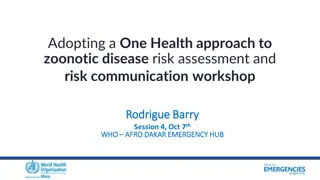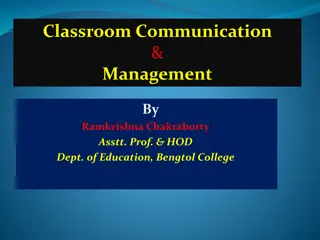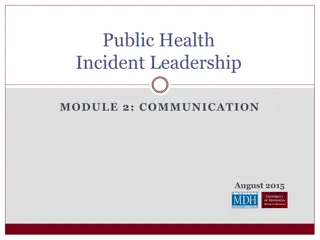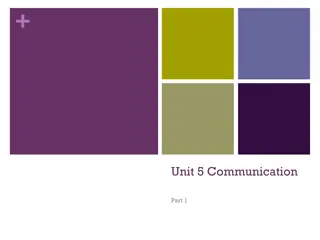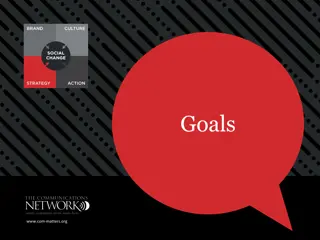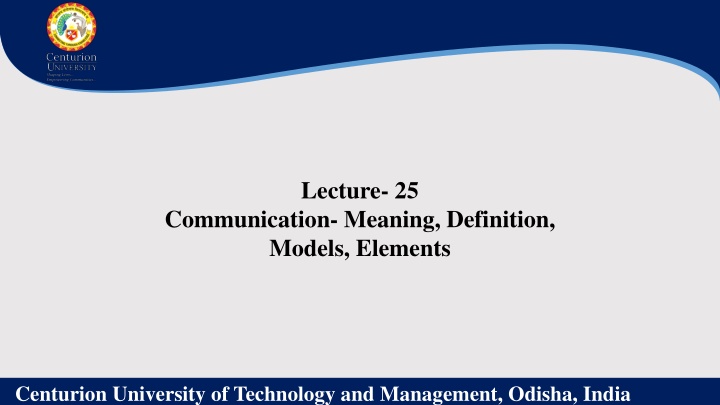
Communication: Meaning, Models, Elements at Centurion University, Odisha
Explore the significance of communication according to Leagans, including its definition, models such as Aristotle's and Lasswell's, and key elements. Discover how communication establishes a favorable environment for development and shapes aspirations, emphasizing its crucial role in leadership.
Download Presentation

Please find below an Image/Link to download the presentation.
The content on the website is provided AS IS for your information and personal use only. It may not be sold, licensed, or shared on other websites without obtaining consent from the author. If you encounter any issues during the download, it is possible that the publisher has removed the file from their server.
You are allowed to download the files provided on this website for personal or commercial use, subject to the condition that they are used lawfully. All files are the property of their respective owners.
The content on the website is provided AS IS for your information and personal use only. It may not be sold, licensed, or shared on other websites without obtaining consent from the author.
E N D
Presentation Transcript
Lecture- 25 Communication- Meaning, Definition, Models, Elements Centurion University of Technology and Management, Odisha, India
COMMUNICATION According to Leagans (1961), Communication is the process by which two or more people exchange ideas, facts, feelings or impressions in ways that each gains a common understanding of the meaning, intent and use of messages. The term 'communication' stems from the Latin word 'communis'-meaning' 'common'. Communication, then, is a conscious attempt to share information, ideas, attitudes and the like with others. In essence it is the act of getting a sender and a receiver tuned together for a particular message, or a series of message. "Communication means the movement of knowledge to people in such ways that they act on that knowledge to achieve some useful result. This result may range all the way from a small improvement in doing some productive task, to the generation of a sense of national unity and strength in a country. Centurion University of Technology and Management, Odisha, India
Importance of Communication 1.Communication establishes a favourable climate in which development can take place. 2.Communication has multiplier effect 3.Communication varies the aspirations of the people 4.Communication is essential for all human activities 5.Communication is essential for good leadership Centurion University of Technology and Management, Odisha, India
Communication Models 1. Aristotle's Model of Communication- The earliest model of communication was the symmetrical and simple model developed by the great Greek philosopher Aristotle some 2000 years before. Aristotle in his model includes the five essential elements of communication, i.e., the speaker, the speech or message, the audience, the occasion, and the effect. In his rhetoric, Aristotle advises the speaker on constructing a speech for different audiences on different occasions for different effects. This model is most applicable to public speaking. Centurion University of Technology and Management, Odisha, India
2. Lasswell's Model (1948)- This is the verbal version of Shannon and Weaver's original model. It is linear. It sees communication as the transmission of message. It raises the issue of the effect rather than meaning. Effect implies an observable and measurable change in the receiver that is caused by identifiable elements in the process. A change in one of these elements will change the effect. We can change the encoder. We can change the message. We can change the channel, and each one of these changes would produce the appropriate change in the effect. Most mass communication research has implicitly followed this model. Centurion University of Technology and Management, Odisha, India
3. Shannon and Weaver model (1949)- The preconception of the academic field of mass communication were heavily influenced by the engineering model of Shannon and Weaver (1949) Communication was conceived as a linear act of transmission of a message from a source to a receiver via a signal producing transmitter. A component called 'noise' acknowledged the presence of context in the electrical engineering model. Centurion University of Technology and Management, Odisha, India
4. C.E. Osgood - Schramm Model (1975)- To the circular model, we have added boxes and arrows showing the influence of noise and personality is a helix used as a model by Frank E.X. Dance. He felt that circular models were better than straight - lines ones like Shannon- Weaver, but that they had a built in error since they showed communication ending up where it started off. In fact as an act of communication goes on, the noise gets less (because the communicators get more used to handling the channel / model) and personality becomes more helpful (because, as communicators get to known each other and the subject, they adjust to each other and fill gaps in their knowledge). Centurion University of Technology and Management, Odisha, India
5. Katz and Lazarfeld's Model (1955)- The model of 1955 was based on earlier research in which they found that information presented on the mass media did not have the reach and impact upon the receivers as previous views of communication seemed to suggest it would. Specifically their research indicated that political radio and print messages seemed to have a negligible effect on individuals voting decisions. Centurion University of Technology and Management, Odisha, India
6. David Berlo's Model (1960)- In the last twenty-five years, a number of models of communication have been developed by communicologists, each one expanding the earlier presentation. David Berlo's model is one among them, which has been profusely quoted and frequently mentioned in discussions. In his book, The Process of Communication written in 1960, he presented this model which has a close similarity to the earlier Aristotelian model, including the traditional elements of source, message, channel and receiver. Berlo's model attempts to explain the various components in the communication process. For each of these basic components, controlling factors were listed. For each of these four components there are five elements that need to be considered. The source and receiver are treated in essentially the same way. To study either we need to consider their communication skills (speaking and writing for the source and listening and reading for the receiver) their attitudes, their knowledge Centurion University of Technology and Management, Odisha, India
Centurion University of Technology and Management, Odisha, India
7. Rogers and Kincaid Model (1981)- One of the more recent models of the communication process is provided by Everett Rogers and D. Lawrence Kincaid (1981). The authors described what they termed a convergence model of communication that stressed the importance of information and the manner in which information links individuals together in social networks. They described communication as a process in which individuals create and share information with one another in order to reach mutual understanding. Centurion University of Technology and Management, Odisha, India





